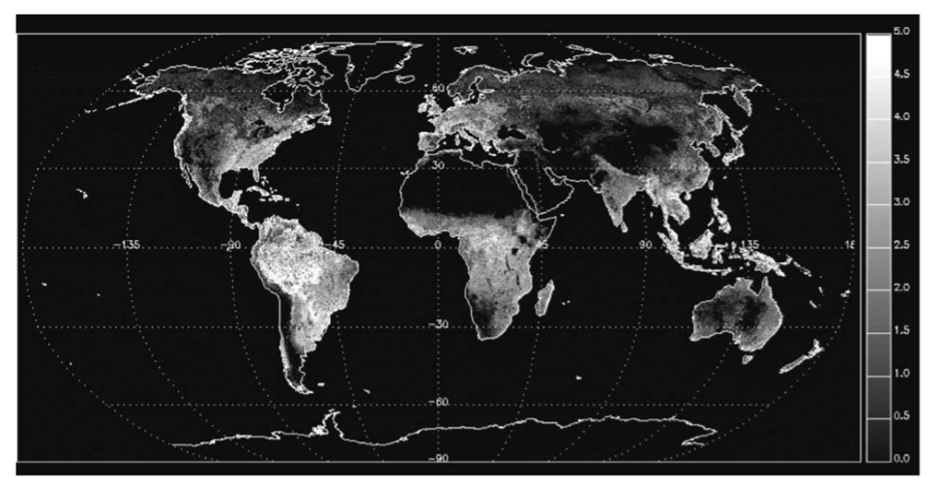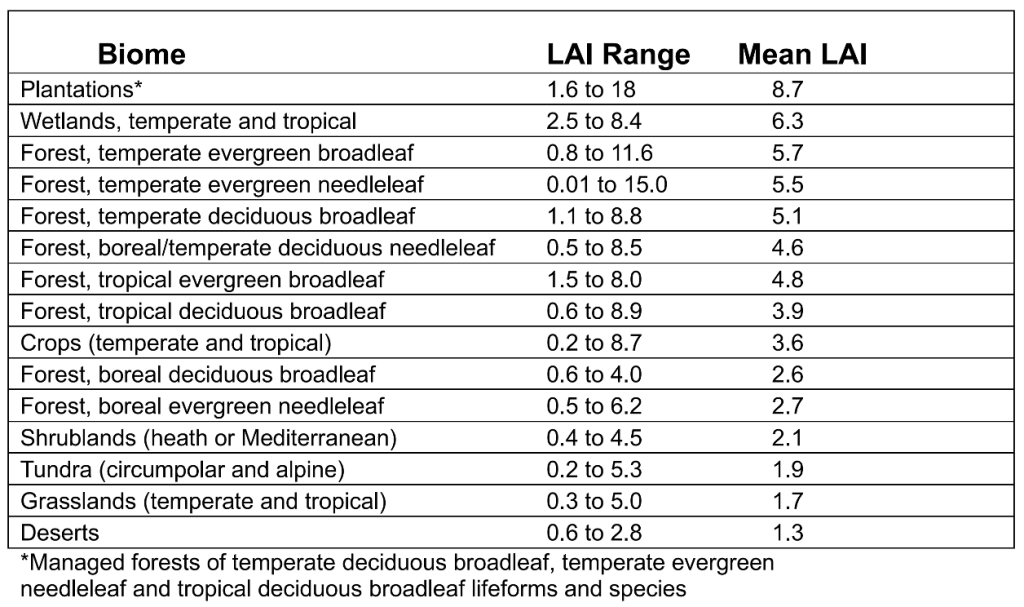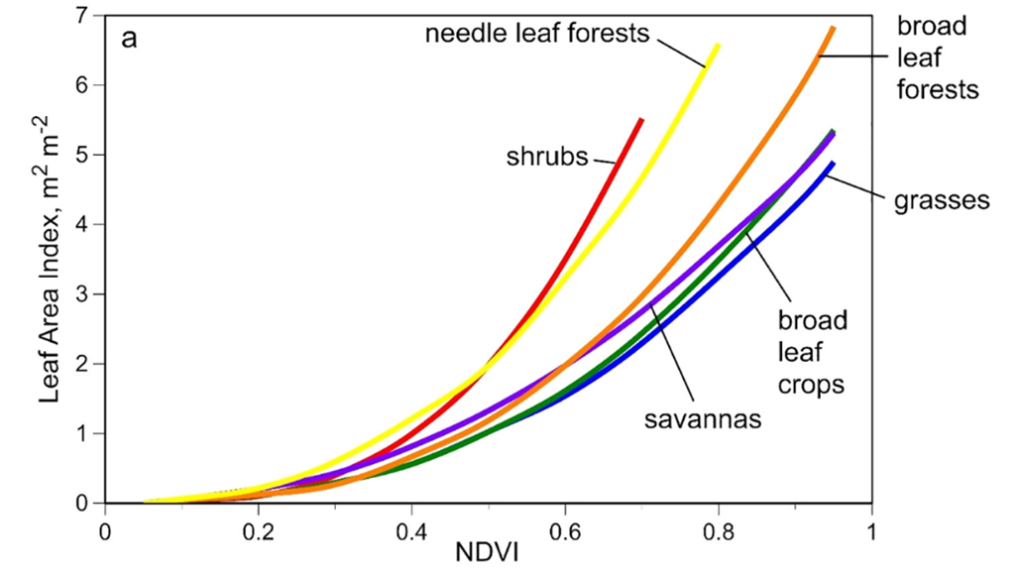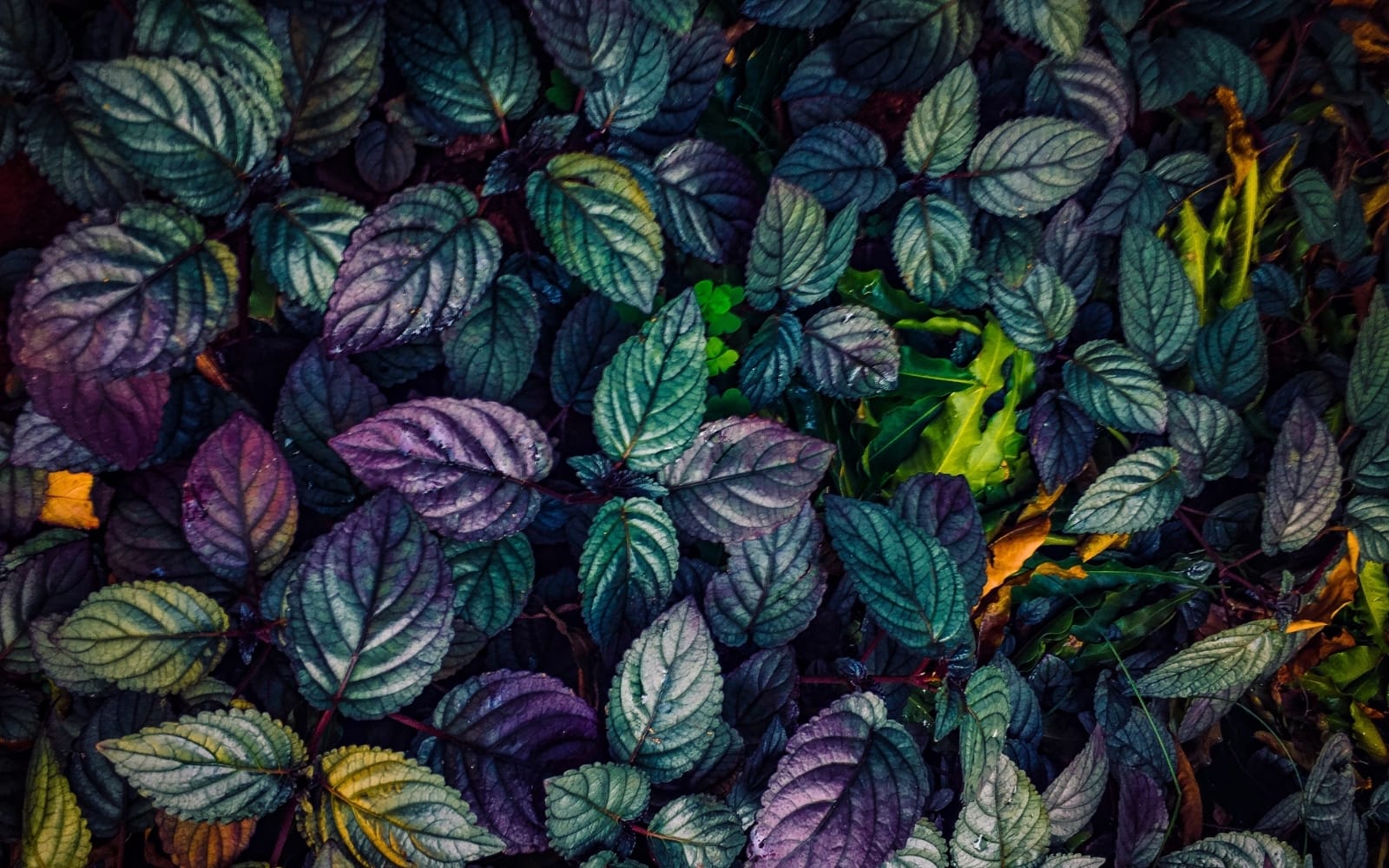September 29, 2025 at 4:36 pm | Updated October 2, 2025 at 7:44 pm | 6 min read
- Leaf area index (LAI) is a key vegetation parameter used in plant research.
- Global collections of LAI show that plantations have the highest LAI and deserts have the least LAI.
- Temperate forests have higher LAI than tropical forests.
- LAI is used to increase food security, support forest research and management, and track the effects of climate change.
Leaf area index is a key plant parameter that scientists use as an ecological parameter of vegetation structure, growth, and productivity for natural and cultivated ecosystems. Since leaves are the primary organs through which plants interact with the atmosphere, the leaf area index determines biological, physical, and biochemical vegetation processes. Leaf area index differs based on growing conditions, climate, weather, and soils, and this article discusses the known estimates for different ecosystems.
Importance of Leaf Area Index
The leaf area index (LAI) is a significant quantitative plant parameter. While various definitions exist for quantifying leaves, Watson’s definition from 1947 is widely used and applied, describing LAI as the canopy leaf area (m2) per unit ground area (m2). Since LAI is dimensionless, the scientific community uses it to measure and compare vegetation across spatial scales, ranging from a single tree or cluster to regions and ecosystems.
LAI is valuable because leaves are the primary organs through which plants exchange energy and several materials with the atmosphere. Photosynthesis, transpiration, and respiration occur mostly through leaves to influence plant and ecosystem productivity. Different growth conditions of temperature, humidity, water, and nutrient availability, and herbivory, influence leaf growth and dry matter accumulation, making LAI a reliable ecological indicator of plant-environment interaction. Hence, it is used in food productivity to measure the success of various agricultural management practices to promote crop growth and productivity. LAI is also used as a measure of the development, health, and productivity of forests and carbon fixation.
Subscribe to the CID Bio-Science Weekly article series.
By submitting this form, you are consenting to receive marketing emails from: . You can revoke your consent to receive emails at any time by using the SafeUnsubscribe® link, found at the bottom of every email. Emails are serviced by Constant Contact
LAI can determine evapotranspiration and precipitation infiltration rates, making it a valuable tool for studying water cycles. As a canopy cover parameter, it is also helpful to estimate deforestation, reforestation, land use change, conservation efforts, surface albedo, and soil moisture. LAI is thus instrumental in many biogeochemical, physical, ecological, and climate research studies.
LAI Values
As a widely recognized vegetation parameter, ground-based individual plot and stand-level, as well as airborne and satellite imagery-based estimations of LAI are standard. There have also been a few global collections of LAI in various ecosystems. The number of LAI estimations is increasing with each decade and uses multiple approaches.

Figure 1: “Global mean annual LAI derived from NASA Sea WIFS sensor and the Myneni et al. (1997) canopy radiative transfer model,” Asner et al (2003). (Image credits: https://doi.org/10.1046/j.1466-822X.2003.00026.x)
Parker (2020) found that various global collections of biome LAI estimations show similar trends:
- Closed forests have an LAI between 3 and 7.
- Conifers have higher LAI than broad-leaved forests.
- Plantations and managed ecosystems have higher LAI values.
- Mixed forests, shrublands, and savannas have lower LAI values.
Asner et al. identified more trends in LAI in their review of 1008 estimations of minimum and maximum LAI from 339 field sites from 15 biomes in 2003. The interquartile range (IQR) method was used to remove outliers and get characteristic values for each forest type. The findings from the review are shown in Table 1 and Figure 1. Asner et al. (2003) found the following trends in their study:
- The global mean LAI is 4.5.
- The ecosystems with the highest LAI were plantations, followed by wetlands, and the temperate evergreen and broadleaved forests.
- Temperate evergreen forests made of broadleaf and needleleaf were the natural ecosystems with the highest average LAI of 5.5 to 5.7, respectively. The highest values of LAI were 11-6 to 15 in evergreen forests and 8.5 in broadleaved forests.
- Tropical forests had lower LAI than temperate forests. Tropical evergreen forests had the highest LAI values of only 8.9, and deciduous forests only 8.0.
- The ecosystems with the least LAI were deserts with an average of 1.3. Grasslands had the second-lowest LAI of 1.7, and the tundra had more with 1.9.
- Deciduous forests had more variable LAI than evergreen forests due to seasonal variations in canopies.
- The higher estimation in needleleaf forests is likely due to the use of direct methods that overestimate LAI.
Table 1. The range and average LAI found in 15 biomes, based on data from Asner et al. 2003. (Credits: https://doi.org/10.1046/j.1466-822X.2003.00026.x)

Factors Affecting LAI
According to Parker (2020), LAI recorded in different biomes revealed the influence of several factors.
- LAI is sensitive to local site conditions, annual variations in weather, and the stand development stage.
- Environmental factors like available moisture influence LAI, but correlations with temperature are more difficult to generalize.
- At large scales, climate and functional types like leaf-form, leaf-type, phenology, and evergreen nature of vegetation are also important. There is a decline in LAI with seasonality.
- LAI estimates based on remote sensing are affected by elevation, precipitation, and temperature.
- Maximum LAI is limited by light above the compensation point over the growing period. (Light compensation is the point where photosynthesis is equal to respiration or when no net production occurs.)
- Canopy stature determines LAI. Vegetation such as annual row crops, shrubs, and vines with high surface density has the lowest LAI. Taller and older forests with more crown differentiation and gaps have higher LAI.
- Within a forest type, LAI increases as the forest develops. In some cases, the high LAI is maintained throughout the lifecycle, but in others, the LAI can decline after reaching a peak.
- The vertical organization of leaf area is as important as the horizontal spread of canopies.
- The outer undulating surface of tree canopies that define canopy rugosity increases with tree height and biomass.
- Stand structure influences the light environment, forming a sun-shade gradient in different forest storeys, which will correspond to varying LAI at different canopy heights. This, in turn, influences basal area and above-ground biomass across most biomes, except temperate broad-leaf forests.

Figure 2: “LAI is commonly predicted with non-linear relations such as from various remotely sensed spectral indices, and relates to different sorts of leaf area arrangements according to plant functional type, besides other factors.” Packer (2020). (Image credits: https://doi.org/10.1016/j.foreco.2020.118496)
Measuring LAI
Three broad approaches exist to measure LAI. These are the direct and indirect methods, which are site-based and suitable for individual and stand-level LAI estimations. The third is for large-scale LAI estimates based on remote sensing data. The method chosen depends on the objectives of the study.
Direct methods involve destructive sampling and indoor estimations. Indirect estimations are non-destructive and are performed on site. Indirect methods estimate LAI by measuring associated parameters that are easy to measure. The CI-110 Plant Canopy Imager, from CID BioScience Inc., uses the indirect non-destructive approach to estimate LAI in real-time. It captures 150° fisheye images of the canopy, and LAI is calculated using the Gap Fraction Method. It offers data-saving capabilities for further analysis and GPS-marking of data collection points in the fields for revisits.
Contact us for more information on the CI-110 Plant Canopy Imager and how we can help with your research needs.
Sources
Asner, G. P., O. Scurlock, J. M., & Hicke, J. A. (2003). Global synthesis of leaf area index observations: Implications for ecological and remote sensing studies. Global Ecology and Biogeography, 12(3), 191-205. https://doi.org/10.1046/j.1466-822X.2003.00026.x
George, J., Yang, W., Kobayashi, H., . . . Pisek, J. (2021). Method comparison of indirect assessments of understory leaf area index (LAIu): A case study across the extended network of ICOS forest ecosystem sites in Europe. Ecological Indicators, 128, 107841. https://doi.org/10.1016/j.ecolind.2021.107841
Ma, J., Zhang, J., Wang, J., Khromykh, V., Li, J., & Zhong, X. Global Leaf Area Index Research over the Past 75 Years: A Comprehensive Review and Bibliometric Analysis. Sustainability, 15(4), 3072. https://doi.org/10.3390/su15043072
Parker, G. G. (2020). Tamm review: Leaf Area Index (LAI) is both a determinant and a consequence of important processes in vegetation canopies. Forest Ecology and Management, 477, 118496. https://doi.org/10.1016/j.foreco.2020.118496
Lv, F., Sun, K., Li, W., Miao, S., & Hu, X. Estimation of Leaf Area Index across Biomes and Growth Stages Combining Multiple Vegetation Indices. Sensors, 24(18), 6106. https://doi.org/10.3390/s24186106
Related Products
Most Popular Articles
- Transpiration in Plants: Its Importance and Applications
- Leaf Area – How & Why Measuring Leaf Area…
- How to Analyze Photosynthesis in Plants: Methods and Tools
- Plant Respiration: Its Importance and Applications
- The Forest Canopy: Structure, Roles & Measurement
- Stomatal Conductance: Functions, Measurement, and…
- Forest & Plant Canopy Analysis – Tools…
- Root Respiration: Importance and Applications
- The Importance of Leaf Area Index (LAI) in…
- Irrigating with Saline or Seawater






